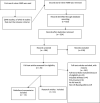Optimal management of older people with frailty non-weight bearing after lower limb fracture: a scoping review
- PMID: 33993209
- PMCID: PMC8266651
- DOI: 10.1093/ageing/afab071
Optimal management of older people with frailty non-weight bearing after lower limb fracture: a scoping review
Abstract
Background: Patients with lower limb fractures who are non-weight bearing are at risk of the complications of the associated immobility and disability, particularly people with frailty, but there is lack of clarity about what constitutes optimal care for such patients. A scoping literature review was conducted to explore what evidence is available for the management of this patient group.
Methods: MEDLINE (PubMed) CINAHL, EMBASE and the Cochrane databases of published literature and the HMIC and SIGLE sites for grey literature were searched for primary research studies and expert reports, using an iterative approach initially including the key term 'non-weight bearing'. All study types were included. Analysis was by narrative synthesis.
Results: No papers were identified from a search using the key phrase 'non-weight bearing'. With this term removed, 11 indirectly relevant articles on lower limb fractures were retrieved from the searches of the electronic databases comprising three observational studies, five non-systematic review articles, a systematic review, an opinion piece and a survey of expert opinion that had relevance to restricted weight bearing patients. The observational studies indicated depression, cognition and nutrition affect outcome and hence have indirect relevance to management. The non-systematic reviews articles emphasised the importance of maintaining strength and range of movement during immobilisation and advised an orthogeriatric model of care. Fourteen UK and 97 non-UK guidelines relevant to fragility fractures, falls and osteoporosis management were found in the grey literature, but none made specific recommendations regarding the management of any period of non-weight bearing.
Discussion: These findings provide a summary of the evidence base that can be used in the development of a clinical guideline for these patients but is not sufficient. We propose that, a guideline should be developed for these patients using an expert consensus process.
Keywords: Fragility fracture; Non-weight bearing; Older adults; Optimal management; Scoping review.
© The Author(s) 2021. Published by Oxford University Press on behalf of the British Geriatrics Society. All rights reserved. For permissions, please email: journals.permissions@oup.com.
Figures
Similar articles
-
Optimal care for the management of older people non-weight bearing after lower limb fracture: a consensus study.BMC Geriatr. 2021 May 24;21(1):332. doi: 10.1186/s12877-021-02265-z. BMC Geriatr. 2021. PMID: 34030635 Free PMC article.
-
Beyond the black stump: rapid reviews of health research issues affecting regional, rural and remote Australia.Med J Aust. 2020 Dec;213 Suppl 11:S3-S32.e1. doi: 10.5694/mja2.50881. Med J Aust. 2020. PMID: 33314144
-
Promoting and supporting self-management for adults living in the community with physical chronic illness: A systematic review of the effectiveness and meaningfulness of the patient-practitioner encounter.JBI Libr Syst Rev. 2009;7(13):492-582. doi: 10.11124/01938924-200907130-00001. JBI Libr Syst Rev. 2009. PMID: 27819974
-
Screening for the primary prevention of fragility fractures among adults aged 40 years and older in primary care: systematic reviews of the effects and acceptability of screening and treatment, and the accuracy of risk prediction tools.Syst Rev. 2023 Mar 21;12(1):51. doi: 10.1186/s13643-023-02181-w. Syst Rev. 2023. PMID: 36945065 Free PMC article.
-
Barriers and facilitators of weight bearing after hip fracture surgery among older adults. A scoping review.Osteoporos Int. 2023 Jul;34(7):1193-1205. doi: 10.1007/s00198-023-06735-5. Epub 2023 Apr 4. Osteoporos Int. 2023. PMID: 37016146
Cited by
-
Early functional mobility predicts return to baseline function and discharge disposition after distal femur fractures in elderly.OTA Int. 2025 Aug 13;8(3):e420. doi: 10.1097/OI9.0000000000000420. eCollection 2025 Sep. OTA Int. 2025. PMID: 40809108 Free PMC article.
-
The influence of immobility on muscle loss in older people with frailty and fragility fractures.Geroscience. 2024 Dec;46(6):5473-5484. doi: 10.1007/s11357-024-01177-1. Epub 2024 May 10. Geroscience. 2024. PMID: 38727874 Free PMC article.
-
Strain energy in human tibia during different exercises with adjustable leg weights: a subject-specific computational model analysis.Med Biol Eng Comput. 2025 Mar 7. doi: 10.1007/s11517-025-03335-9. Online ahead of print. Med Biol Eng Comput. 2025. PMID: 40053302
-
Open lower limb fracture reconstruction in the elderly population: the experience of a major trauma centre.Eur J Trauma Emerg Surg. 2025 Jan 16;51(1):20. doi: 10.1007/s00068-024-02688-4. Eur J Trauma Emerg Surg. 2025. PMID: 39815042 Review.
-
Causal association between air pollution and frailty: a Mendelian randomization study.Front Public Health. 2023 Nov 7;11:1288293. doi: 10.3389/fpubh.2023.1288293. eCollection 2023. Front Public Health. 2023. PMID: 38026367 Free PMC article.
References
-
- Namba R, Skinner H, Gupta R. Current Diagnosis & Treatment in Orthopedics. 4th edition. New York: Lange Medical Books/McGraw-Hill Medical Publishing Division, 2006; 720.
-
- Anderson TB, Duong H. Weight Bearing. InStatPearls [https://www.ncbi.nlm.nih.gov/books] 2019. USA: StatPearls Publishing LLC [Internet]. - PubMed
-
- Ruedi T, Buckley R, Moran C. AO principles of fracture management, books and DVD. Stuttgart, New York: Thieme, AO Pub, 2007.
Publication types
MeSH terms
LinkOut - more resources
Full Text Sources
Other Literature Sources
Medical


